You’re listening to Burnt Toast!
We have another Comfort Food rerun for you this week. Hopefully, by the time you’re listening to this, I have turned in my book manuscript, and I am taking this week to chill out. It’s the first week of July and we’ve got family visiting. My whole goal for this first week is to just spend a ton of time in my pool and my garden, and let my post book brain melt. There’s a stage in book writing where you just feel like you have used all the words. There is nothing left and you have nothing to say. But don’t worry, it’s temporary! It always comes back.
And I will be back in your feeds next week with a brand new podcast episode, so make sure you’re subscribed to get that in your podcast player.
In the meantime, we are revisiting the Comfort Food archives again. This is episode 53 which aired on December 5, 2019. Our guest on this episode was Jennifer Berry, who is a feeding therapist and founder of Thrive by Spectrum Pediatrics. I’m a huge fan of Jeni’s. I first met her when I was reporting a story for the New York Times Magazine in 2015. I mean, we go way back. I spent a lot of time reporting on the approach that Jeni and her colleagues take towards child-led weaning off feeding tubes and child-led feeding therapy in general—or responsive feeding therapy, as it’s now known. Jeni is just a really trusted source on all questions related to family feeding, all the dynamics, how to think about the different skills, the emotional development piece of it, and the nutrition piece of it.
This conversation is about why nutrition is much less important to successful family meals than we think. I know that may feel uncomfortable for a lot of us. We hear all the time that our big responsibility as parents is to feed our kids a healthy diet and more fruits and vegetables and all of that. But that so often gets in the way of feeling good about how you’re feeding your family. So we talk about how to set aside your nutrition anxieties at the family dinner table and how that might improve some of the struggles you’re having there.
But Jeni is a trained therapist with a strong research background. I’m a health journalist. So we also talk a lot about the way that nutrition science gets done, and how flawed and misleading both the studies themselves can be and the media coverage of nutrition science. We talk about how to interpret what you’re seeing in the media and by media, I mean mainstream media outlets and I also mean social media. When you see people throwing out statistics throwing out these really broad claims about different foods, or making claims about “healthy” eating in general. So I think this is another super useful episode!
Keep sending in your questions for Virginia’s Office Hours! If you have a question about navigating diet culture and anti-fat bias that you’d like to talk through with me, or if you just want to rant about a shitty diet with me, you can submit your question/topic here. I’ll pick one person to join me on the bonus episode so we can hash it out together.
And don’t forget: Next Wednesday, July 13 is our first Burnt Toast Book Club! We’re reading The School of Good Mothers by Jessamine Chan and wow is that book even more of a gut punch now than when I picked it. CW for child endangerment, prison abuse, foster system abuse, mother shaming (to put it mildly) and psychological torture… but also know that this book is compulsively readable, heart-breaking, and thought-provoking in all the best ways. I’ll post the book club thread at 12pm Eastern on Wednesday, and be on there live for the hour. (But if you can’t join us at that time, feel free to join the discussion later—that’s the beauty of a thread chat!)
Episode 50 Transcript
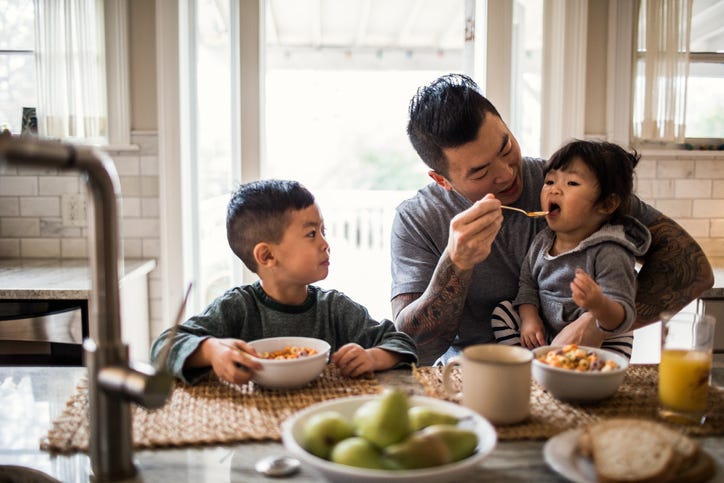
Virginia
Hello and welcome to episode 53 of Comfort Food! This is the podcast about the joys and meltdowns of feeding our families and feeding ourselves.
Amy
This week we’re talking about what to do and everything you know about nutrition is starting to make you a little crazy. Because sometimes what you know about nutrition seems to not be true depending on the day. So we’re gonna brainstorm some ways you can find a better balance for yourself and your family with a very special guest.
Virginia
I’m the author of The Eating Instinct: Food, Culture, Body Image, and Guilt in America. I write about how women relate to food and nutrition and our bodies in a culture that gives us so many unrealistic expectations about all those things.
Amy
And I’m Amy Palanjian, a writer, recipe developer, and creator of Yummy Toddler Food. And I love helping parents to stop freaking out about what their kids will and won’t eat and also about nutrition news because lately it’s been like every week, there has been something in the news that is just…
Virginia
It’s been kind of crazy. So this week, we are so happy to have Jennifer Berry of Thrive by Spectrum Pediatrics back on the podcast. Jeni, welcome.
Jeni
Thank you. Hi! How are you guys doing today?
Virginia
We are good. We are so excited to be talking to you. You are a fan favorite on the podcast and our listeners mostly will be familiar. But for folks who are new to the podcast, let’s remind them or tell them who you are and what you do.
Jeni
So I am an occupational therapist by trade and a feeding therapist by specialty. And I’m the owner, as you said, of Thrive by Spectrum Pediatrics. We work with families near our headquarters in Alexandria, Virginia, but also all over the United States and beyond, helping families help their children overcome feeding challenges. We work with kids that are feeding tube dependent, helping them wean from their feeding tubes, we help kids that have severe feeding aversions, motor problems with eating, all the way through the kind of everyday common hurdles that families face at the table.
Amy
And for listeners who want to know more about Jeni and her approach to food, check out episode 28, when she was on last. We talked about what to do when your kids just don’t eat dinner.
Virginia
A perennial problem. So, today’s episode came out of an email conversation that the three of us had after Jenny listened to episode 46, where we talked about the new nutrition guidelines from the Robert Wood Johnson Foundation saying that kids should not drink chocolate milk or juice before age five. So, we were then talking afterwards with Jenny about how hard it is to balance the “knowledge”—and I put that in quotes because, as Amy said, the information can change so wildly. We have all this information these days about nutrition and what we think our kids and we ourselves need to be eating. But how do you incorporate that into just being present with your families at meals. And Jeni had this really beautiful analogy, comparing it to yoga. So Jeni, tell us about that?
Jeni
Because I’m so immersed in this world, both as a mom who feeds kids, and also as a feeding therapist who looks at these studies that you’re talking about, that have so much different information, some of it good, some of it competing. It occurs to me that we get so caught up in that information. The yoga analogy was, if you’re learning a yoga pose, for example, you have to first learn all the technical aspects, like the posture and the breath, positioning—all of that is really important. You can’t do without the technical knowledge. But in order for it to be like truly yogic or in order for you to experience the pose as it was meant to be, or this probably applies to sports and other performance, and other areas of life. But in order to really experience the yoga pose the way that it was designed, you kind of have to take all of that technical knowledge, and set it aside and be in the pose. I tend to look at feeding kids in the same way. We have all of this information on the macro level. We are really fortunate to have access to all of this information that floods us every day about what foods we should feed our kids and why. And then not let it seep into everyday decisions because it takes us away from our kids. I feel like it also leads to a really unhealthy kind of dynamic for us as parents and between our kids that we can get really stuck and overly focused on doing things the right way. The trick is to have the knowledge and then to let it go and then be with your kids and try to make decisions. I don’t know that it’s easy. I know it’s not easy for me. But I think it is possible to work towards that and have a little bit more freedom for you and your child.
Amy
Is this something that you see your clients struggling with often?
Jeni
It’s universal. Yeah, not only my clients but my friends that are parents. I don’t really know many parents that don’t struggle with it, honestly.
Amy
I was thinking, as you were explaining that, the other night we went out to dinner and it happened to be a restaurant that had calories listed on the menu. I was like, oh!
Virginia
It’s everywhere in New York, but I think it varies by state.
Amy
It really threw me because I’m not used to having that information when making food choices. I feel like I’m a pretty informed person and I feel like I usually can push that stuff aside, but I was really stuck.
Virginia
Because it’s right there in front of you! And then it feels like, oh wait, is every decision I make around the meal supposed to focus on this one aspect? But, you know, of course not! Especially when you’re trying to like help your three year old decide what to have for dinner.
Jeni
And keep your sanity.
Amy
And keep the three year old from climbing underneath the table.
Virginia
That ship has sailed at my house.
Jeni
I think that’s a great example of the burden that can come with information. I do think it’s really hard to negotiate and that’s a really concrete example. But there’s lots of really subtle ways, too. We want our kids to be healthy across the board, not just around food, and so it carries a lot of weight with us. I do think it’s a real challenge. I think it can be done, to kind of hit that just right balance between having the knowledge and using it at the right time to make decisions.
Amy
Virginia, could we just pause for a minute, so that you can tell us like some examples of where we might be getting this information just so that we can be a little bit more clear with our listeners about what we’re talking about here?
Virginia
As someone who’s been a health journalist for 15+ years now, I both experience this as a consumer of media, like we all are, but also this is what I do day-to-day, putting these messages out there. For a long time, this is what I did. So what we’re talking about is the nutritional information you get when the morning news is talking about how everything you know about red meat is wrong. Or, the New York Times reports on it. Then it gets distilled further, because it comes not just from these news sources, but also from a meme on Instagram or Facebook or a thread on Twitter where everyone’s weighing in. A lot of them maybe are experts, and maybe they aren’t. We’re getting our knowledge about nutrition from a lot of different sources these days. And the problem is these sources are definitely not all created equal. Just because somebody puts it on a pretty graphic on Instagram does not mean they bothered to look up the study that was done or actually evaluate the quality of the research to see whether it’s a useful tidbit to share. This is not just to put Instagram on blast, although I do think it’s a huge issue there and Pinterest, and other places where this gets disseminated. But I think it can be useful to know a little more about how to actually evaluate the information when you get it.
Some strategies that I use as a journalist that I think are not hard to learn—I think anyone can do this—always, when you’re given a new piece of nutrition news, figure out the primary source for it. Don’t just trust the Instagram meme. But also don’t just trust the New York Times or any media reiteration of it. Because that means a journalist—it’s like a game of telephone. You’re that much further away from the source. What is really useful to do is to go look up the actual study they’re reporting on. In newspaper articles, especially if you’re reading online, they’ll usually hyperlink to it. Or, if you Google the researcher’s name and the study topic, you’ll find it pretty quickly. You may only be able to read the abstract, which is the research summary, because often you have to pay to read full research papers. But even the abstract, you can get a pretty good sense of how robust it was, this research. It’s important to know, especially with nutrition research, it’s very difficult to do high quality nutrition research. It’s very expensive and time consuming. So, a lot of small studies come out that are done much more quickly and the data is just not as robust.
So, a couple of things to look for when you’re dissecting and abstract. Start by looking at how many people were involved in the study. If it was a study done on 16 people, it’s not very relevant to anybody’s lives. It’s a case report. It’s interesting, but it’s not. If it’s data collected on 1,000 people and they were a nationally representative sample where they tried to make sure that 1,000 people in the study have characteristics—age, socioeconomic status, gender, race—that are representative of the United States, or wherever you are, that’s more of a useful population. Or if it’s a study done on 50 year old men and you’re a 30 year old woman, it’s not going to be relevant to you, particularly. You want to look at research that was done on a population that’s comparable to you and your family.
You also want to look at how long they were followed. So often, this is happens all the time with weight loss studies. They’ll see a big result after about six weeks of following some program. But they won’t bother to follow up with people at six months, 12 months, two years, five years. And you really want to know what happened at that point. How long did they see this benefit? Whatever big takeaway they’re claiming about the study, did it really last?
And then the other thing with nutrition research, because it’s expensive for researchers to make food and feed people directly for two years, usually they’re just having themselves report what they ate. And people are not very reliable with that. So that’s another one to really pay attention to. Because if it’s all self reported data, it’s probably not as ironclad as if they sat in the lab for two years. On the other hand, if they sat in the lab for two years, it’s not real life. So that’s a drawback with that kind of research.
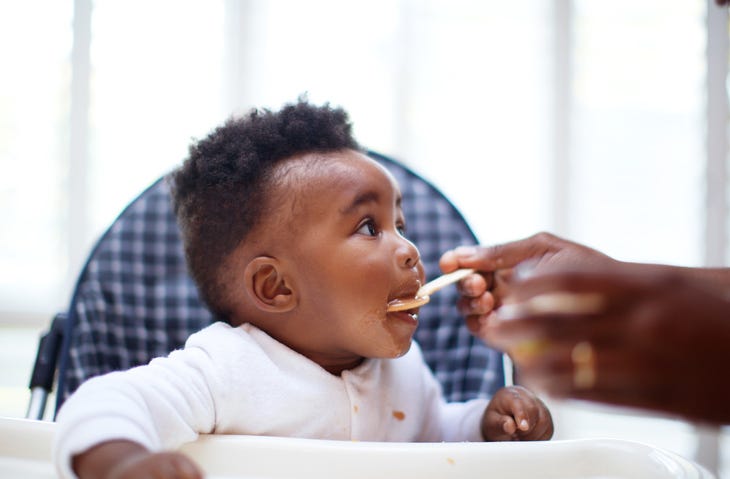
Amy
Jeni, do you have other strategies that you would want to add here?
Jeni
Just to just to reinforce what Virginia’s saying, those same tips I would use. The two that stand out to me are the length of time. We often get a study about a certain nutritional ingredient or a certain way of feeding a child—an example would be in my feeding therapy world, there’s ways of feeding kids and they have a protocol, they apply it to a small group of people, and then they examine them, they see how the kids are doing with eating, expanding their food choices for kids that have a limited amount. They’re using a behavioral approach. This is the example I’m thinking of right now, where they’re kind of rewarding the kids for eating it. And what the study shows, in the study that I’m thinking of, is that the kids eat more. What the study doesn’t do—it’s just good to know what’s not there, and I think you’ve pointed that out, Virginia. What it doesn’t do is show what impact it has to reward kids for eating in two years, four years, five years. There is research out there about how we feed kids that has been out there for a long time that does follow kids more longitudinally, over long periods of time. But so to me, the biggest one that affects most parents in the work that we do, is that they’re looking at short term studies or studies that don’t follow them. And then this other thing that came up in our email exchange that we were referring to, which is the correlation versus cause.
Virginia
Yes, this is really, really big. Jeni, explain this, because this is critical to understand about nutrition, all kinds of research, really.
Jeni
We often, as consumers who are not sitting around in a research lab and analyzing data, it’s really easy to to see a study and think that one thing is linked to another. In the example that we were talking about after the the last episode, about the chocolate milk and drinks, there was a study that said that kids who are exposed to different flavors, had an increased incidence of being more willing to eat flavors, or having a broader diet later. And they were exposed when they were babies. So lots of different flavors, it was a predictor of more choices or variety later on. And while that may be true, it wasn’t saying that that’s why. It wasn’t saying that the reason that the children were eating more foods later in life was only the food choices that they tasted or were exposed to. So I just think it’s helpful to point that out, because there are lots of factors that go into it. And in that that example, in particular, what’s more important to look at is the big picture. If the children were forced to eat those foods in wide variety, forced or coerced to eat them, my guess would be that the results of the study would be very different. Based on what we know about responsive feeding and lifelong healthy relationships with food. I just think it’s super important that we not mistake, something being correlated or a predictor of another thing as being the black and white answer of what’s causing it. Those are different things.
Virginia
It’s easy for parents to misinterpret that and think, I have to get my baby to eat tons of different foods.
Amy
This is why there are like, if you Google “baby food chart,” there’s all of these charts of 100 foods to give your baby before they turn one because if you do that you won’t have a picky eater and it’s just not true.
Jeni
Then the moment your child throws number three on the list on the floor, you’re left questioning yourself and it’s stressful. And then you’re less likely to offer those foods in the future. To take it back to the longitudinal aspect of things and looking at things in the long term, there actually is a lot of research, but also just information about the long view, and what we know works best for kids. What we know is what you guys talk about in most episodes. Which is that if kids are taught healthy messages about their own bodies; if they’re not being subjected to messages that are negative about their parents or other’s bodies; if they are not having foods that are viewed as unhealthy restricted completely from their diet or shamed for eating them; if they’re not being pressured or forced to eat foods that are viewed as healthy by the people that are feeding them; and then if they’re allowed to read their cues for fullness and hunger, which is not always easy—but if that happens, there is a lot of weight behind those things in the research. But also in my clinical practice, you can just see those kids become more confident, healthy eaters in the long run.
Then, if I may just go back to that study about exposure, because that’s what prompted our whole conversation. Exposure is super important. It’s really important that we expose our kids to different foods, but that exposure doesn’t necessarily mean it goes in their mouth. We can expose kids to a wide variety of foods while honoring their bodies, while not forcing them or having them silence any fear or discomfort or disinterest they have around a food. We can expose them to it by eating it ourselves, by having them be involved in the preparation of it, by taking them to the grocery store. There are lots of ways to expose kids, in a healthful way, to a variety of different foods without putting that insane pressure on ourselves, that they have to eat that huge list that you saw on Instagram or Pinterest. And so I just like to keep reminding parents of that, that our job isn’t to dictate what goes in.
Amy
I think a lot of times that the exposure issue gets misconstrued as your child needs to taste this thing 20 times before they will like it. That’s just not that’s not the way that that works.
Jeni
No, it’s not the way kids work. So there’s an actual thing out there called “neophobia,” which you guys have talked about on here before, which is that it’s a developmentally appropriate around preschool age for kids to be afraid of trying new things. So it’s not that that’s going to make them like it, it’s for them to feel comfortable enough to try it, the newness has to go away. And the newness doesn’t go away in two offerings or five offerings and often not in ten. Your kids need to see things consistently, in different settings by different people. That doesn’t mean you should be like having a notebook next to your table with and checking off how many times you’ve offered sweet peppers or whatever. But it does mean that it takes a minute. It’s normal that your child doesn’t try things in the beginning and that when they try them, they reject them. That’s a typical part of development.
Virginia
That is super reassuring to hear. And I think again, framing it around not getting too literal about how we interpret this research is really helpful.
Jeni
We try to coach parents that when you’re just making decisions about how to feed your kids, you’re not making big decisions about whether you’re doing it right or big shifts in how you’re doing it in the moment when your kid is throwing the food on the floor. You’re going to do it away from the mealtime. You’re going to do it in a time where things are relatively unstressful. We call it checking in with yourself or checking in with your partner about how the mealtimes are going. You make the decisions about what your kids eat at the grocery store and when you decide who you surround them with, what school you send them to, and then whether or not you decide to team with those people and collaborate with them in a trusting way. And then when you’re assessing if it’s going well, a meal, it hasn’t to do much with what goes in their mouth. It has more to do with the internal drives to eat. And the internal drives to eat are not just hunger. Hunger is a big one, but togetherness is an internal drive to eat. Curiosity is an internal drive to eat. Novelty is a natural internal reason that kids want to eat. And comfort! Here we are talking about comfort food, but those are the those are the natural drives in childhood for learning to eat.
So if you step back, and try to keep those at the forefront of your mind when your child is eating. At the meal or at the party or wherever it is where you’re feeling conflicted about what choice to make, try to just think about those. And if you’ve got one of them, things are going okay. If your child is enjoying time together around food with a peer, then one of the internal drives to eat is being met and that’s important and valuable. Even if it’s just comfort, there’s a time and a place for that those are really important things and we’ve talked about that before. And it’s also okay, occasionally, if those things aren’t present. because we all know that that does happen occasionally and we have to give ourselves a break. It doesn’t mean that if you mess up, or if a situation comes up, there’s a surprise or whatever, somebody said something unfortunate at a birthday party to your child about their food choice, that doesn’t unravel everything else you’ve done. It doesn’t erase it. The message is about what you’re sending on the whole. It’s a more of an umbrella message that you’re sending that matters, that stays with the kids versus those tiny, little individual episodes.
Virginia
That is a really helpful perspective. I love that it.
Amy
And it can for sure be hard to do that in the moment. But I think the more that you practice this sort of the easier that it gets.
Jeni
Everybody’s different in terms of the way that they need to be reminded about things or the way that they learn or help themselves through tasks that are difficult. I’ve had parents write down the internal drives to eat and keep them on the refrigerator or have a list of them on their phones.
Virginia
Oh that’s a great tip!
Amy
I guess we’re gonna be making a little printable for everybody. Unless you have one that you want us to share.
Jeni
I don’t! Make it, it sounds great. I want one.
So that is one strategy that people use. I think another one that people have used is really looking at your child and how they’re doing in other areas. Health is about more than food. Health is about the whole child. If they’re happy, and participating in school, and if they’re affectionate and emotionally doing okay, if they’re able to be themselves and they are meeting milestones and they’re progressing, then we’re in a good spot. We don’t have to have it be all about the food all the time.
I’m a developmentalist, by training. And so I look at development, but in childhood, we don’t expect kids—or adults for that matter—to perform at their best 100% of the time. Mastery we consider when we look at developmental milestones is 80% of the time. 20% of time, it is not going to be happening. So a decent meal, not their best meal, is going to happen 80% of the time. It doesn’t mean that everything’s going to be easy. It doesn’t mean what your kid is eating, it means these other components.
Virginia
How well the overall meal experience goes.
Jeni
Based on these internal drives to eat, which includes togetherness. 80% of the time, if you’re there, you’re doing it, because that’s human nature. That’s the nature of learning to develop and figuring things out. Nobody’s at 100%. And there’s a lot of pressure at 100%. If we’re expecting ourselves and our kids to do their best and to be in the moment and we’re as parents incorporating all of this information that we’re being bombarded with, not just about food, but about how to plan a birthday party, and how to be the best parents and juggling our work and our home lives, there’s no way that we can do it at our best 100% of time. And we also are then setting our kids up with unrealistic expectations.
They need to be able to go out into a world where there is non-responsive messages being sent all the time around food. If we if we create a world for them around food where they only are experiencing the messages that we really want them to experience, those responsive messages as I call them, then what’s going to happen when they need to learn how to contend with the non-responsive things, too? And that’s what we’re here to help them do that as parents.
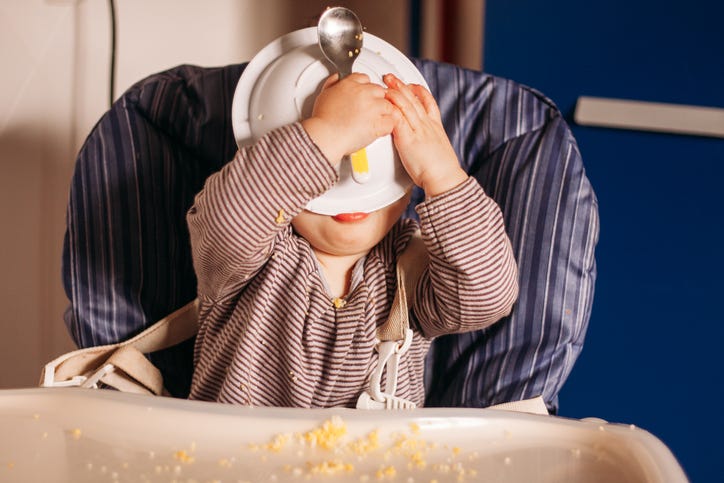
Virginia
That’s so interesting. Do you find that the percentages change when kids are struggling with something else? And the reason I’m asking is, on last week’s podcast episode I talked about both my girls, their list of safe foods had gotten a little shorter recently. Beatrix just turn two, so neophobia arriving. And then with my older daughter, when she’s going through different periods of stress in her life this is the area where we often see she’ll get a lot more particular about food. She’ll get much less adventurous again. I’m wondering if that’s something that people might commonly see and you might zero in on feeling like food is the problem, but is it helpful to sort of look more broadly at like, oh, well, they’re just learning to read or they’re mastering potty training or something else is going on that’s maybe causing meals to sort of plateau a little bit. Does that make sense?
Jeni
Yes, it does make sense. Absolutely. Yeah. These are more like umbrella averages for the big picture of how our years and our months are going. The literature that shows—although we have to, again, be careful about these studies—but what we know is that when a child learns to walk, sometimes they talk a little bit less or vice versa. We have a finite amount of energy and bandwidth on certain things. And so, of course, it makes sense that if you’re going through a challenge in one area, you’re going to hunker down at a different level than you might have the week before in another area of development. So yes, that’s absolutely true with food, too. It’s true across areas of development.
Virginia
Another reason not to get so hung up on the nutrition piece. If you take a more holistic look at your kid and think about why broccoli is less interesting this week, it might not have anything to do with the broccoli.
Jeni
Exactly, it probably doesn’t. I hesitate often with families to ever talk about numbers, honestly, because so much of the most important predictors of how well kids are going to do with food feeding challenges, but then how well they’re going to relate to food later, has to do with qualitative stuff. And if we focus on anything with a number, it takes us away.
Virginia
People are suddenly calculating.
Jeni
As long as you’re changing your the framework that you’re assessing things by. Is your child thriving? Are they growing? Are they meeting milestones? Are they relatively happy? And then, are you looking at those internal drives to eat: togetherness, curiosity, hunger, novelty and comfort. You know, if those things are there 80% of the time, you’re good. And I think we’re hard on ourselves. I think they are there most of the time. I think some of those components are present in most of the meals. I think you’re there, most people that are listening are probably already there. It’s just because we have all of this other information, we get lost. We get distracted from what’s the most important and what is truly the best predictor of a child feeling safe and comfortable around food. And now and then later, which is, which is these more qualitative things.
Amy
On that note, I did want to just remind everyone that when you’re seeing headlines, from news organizations or websites, like I put myself in this list, all of these sites are making money from people being on their site. So they have a very real reason to make you want to click on that link. The headline may be completely misleading. And it may be completely taking whatever the study was out of context. So just take a minute to realize that someone is trying to make a dollar.
Virginia
and don’t email the author of the article and yell at her because we don’t get to write our own headlines. The editors do that to us. Anyways, Jenny, thank you so much! This was such a great conversation. This was super, super helpful. Will you tell our listeners where we can find more of you?
Jeni
Oh, sure. We can be found at Thrive With Spectrum and we can be found on Twitter, Instagram, and Facebook. We’d love to hear from people.
Amy
And we’ll have all of those links in the show notes. And if anyone has follow up questions for this or wants more information on anything we talked about, you can either send us a message or comment on our show notes.
Virginia
All right now coming up. I have some breaking news on the Beatrix bottle, so stay tuned
Unrelated
Amy
So, Virginia, the other day you had posted something on somewhere—I can’t remember where—how about you put Beatrix to bed without a bottle!
Virginia
It finally happened, you guys!
Amy
So we’ve been talking about this since the spring, I think?
Virginia
Yes, Episode 37. It was the end of season two, was when we went like deep dive into milk weaning and that is like our most popular episode ever. So I have a feeling I’m speaking to a lot of you right now. Because people really like to talk about milk weaning. We talked about both breastfeeding weaning and bottle weaning. And this was a journey for me, because I’ve talked about the traumatic feeding experiences with my older daughter and how cathartic It was to be able to first breastfeed Beatrix successfully, and then make the decision around four or five months that I was ready to just go over to formula and really embrace that. And I just derive so much joy out of feeding her. I mean, that’s not breaking news to anyone who listens to this podcast, feeding babies is great. When it works well, it’s really wonderful.
I am not someone who is super sentimental about losing the baby stage. Like my husband and I basically throw a party on every birthday like, oh my God, our lives are finally getting easier. I don’t ever want another newborn in my life. I like other people’s, but I don’t want to have one. But the bottle was the one thing that I was sentimental about. This was a big stage. So I think a lot of this was me needing to be ready as much as her needing to be ready. But she’s also a kid who loves her bottles.
So what we did last spring, I think it was like her 18 month checkup, our pediatrician was like, “Yeah, you have got to get started on this. There’s no medical or physiological need for her to have a bottle.” We had switched, when she turned one, over to regular milk from formula. And she was still, around 18 months, she was still on like five bottles a day. And it was like, how are we going to do this? So I talked in those episodes—you can go back to Episode 37 and hear how we dropped down to just having a 4-6 ounce bottle before nap and before bedtime, and we were able to pretty seamlessly drop the daytime bottles. Then we just, we just stayed there for a while. We were like, it’s fine. We’re going to just hang out with these bottles because they were part of her bedtime routine and they were really comforting. And we were all, both me, Dan, and our babysitter were all like, “Oh, this is not gonna go well.” So then when we had her two year checkup, the pediatrician was like, Aren’t you done? Which, you know, pediatricians, I feel like they just think it’s this really easy thing. And they forget how emotional this is. It’s not just like I want to just put it away and be done with it.
Amy
My pediatrician asked me at our nine month checkup if meals had been replacing nursing sessions, and I was like, What? No, he’s a baby. How long has it been since you’ve had a baby? Because I feel like that’s really out of touch.
Virginia
It’s really out of touch. That’s really weird.
So anyway, we kind of hemmed and hawed about it. And so we have taken this very gradual approach. And I don’t know, maybe if we had just put all the bottles away at 18 months, it would have been fine. That is entirely possible. I think that works great for a lot of kids. So when I’m talking about what we did, guys, I’m not saying anyone needs to do it the way we did. But, if you are feeling ambivalent about this, or have a lot of emotions to process, I think a gradual approach can be helpful because it gives everybody time to get there. So after her two year checkup, we decided, Okay, we’re gonna take the pre-nap, pre-bedtime bottle, which at that point was four ounces, and we’re gonna take it down to two ounces, which sounds really silly. But I’m really glad we did it, because it gave her a few days. She was mad about it, like she would finish it, and she would be like, let’s go back downstairs, I need more bottles. There’s not much milk here, Mommy. She was very straightforward, like, you didn’t put enough in. Then I would say, “Nope, that’s all we’re having today.” And she would throw the bottle and be mad about it. And it just let her let out some of the feelings about it.
We did that for a full week. On Sunday and Monday of that week, she was furious. It was like a thing. And by Wednesday, she was sort of like, ugh fine. And by Friday, she was barely finishing the two ounces. It just gave her that time to work through it and accept the change in routine. The other thing we did, not deliberately, but looking back I think was helpful, was we kept everything else very consistent and down to the books that she wanted to read. I think we all read Curious George and the Dump Truck 900 times that week. We just kept reading the one book that she was most reassured and comforted by over and over and over. So I think that helped reinforce not that much is changing. You’re still getting your snuggles you’re still getting all the cozy bedtime reading and everything, just a little less milk in the bottle. That’s it.
And then Sunday night. So, we never want to mess with weekend naps because you know, obviously. So we kept it over the weekend, the two ounces, so she would still nap and we would have our break. But then Sunday night bedtime, I was like Okay, let’s do it. We went upstairs and I had this last minute thought, I was like, Oh, maybe a toothbrush. Let’s brush your teeth, which we had a miss on at bedtime. And we went and got her toothbrush, which was super excited about and then she brushed her teeth the whole time I read the story, and she didn’t even ask about the bottle at all. It did not come up. She was totally happy.
Amy
Wow. Had you been giving her a bottle before nap time?
Virginia
Yeah, we had had both. That’s why I’m saying, over last weekend we didn’t drop the nap time bottle, so that bedtime was the first time because I didn’t want to lose that two hours of unconscious toddler. I didn’t want her to not nap. So I waited until the bedtime to do it. And she still didn’t even really reference that.
Now, the next day, Monday, she did remember. When our babysitter took her up to nap, she remembered about the bottle and she asked for it. And same when Dan put her to bed that night. And there was maybe, both times, five minutes of feelings. And then she was happy to sit with the toothbrush brush her teeth while being read a story. And last night when I put her to bed, it was like on the way up the stairs, she was like, “no more bottle.” And I was like, “that’s right.” She does this thing where she puts her head down and she goes, “it’s gone forever.” She’ll say this about anything, though. She said this about her baby gate. The baby gate is gone forever. She’ll finish her Cheerios, it’s gone forever. So, it’s like just her way of acknowledging. And then I was like “yeah, you’re a big girl now, you know, isn’t that exciting? Let’s go get your toothbrush.” And she was fine.
Amy
That’s so sweet. You had also mentioned something about saying goodnight to all the..?
Virginia
Oh, yeah, that was the other thing. She has actually been building that herself—I think it’s bedtime stalling. It’s definitely a bedtime stalling tactic. We’ll get halfway up the stairs and she’ll go, “I need to say goodnight to the playroom.” We’ll go back downstairs and she’ll go, “Goodnight playroom, good night trampoline, goodnight sofa, goodnight pillow.” She’ll just like pick random things she needs to say goodnight spoon. And so we did that as well. That and the toothbrush combination seemed to just give her the touchpoint she needed. She has other ways to self soothe, that was just one option. I don’t feel like this has in any way undermined her sense of security with anything. So that was my goal.
I think the takeaway is there’s no right way to do this. It’s going to be different for everyone. There’s this kind of myth out there that like you have to rip it away and it’s going to be brutal for two weeks, and then it’ll be fine. And I don’t know that it has to go that way. I think you can find a gentler approach and that can be good too.
Amy
Yeah, and there’s no timeline that works exactly the same for everybody.
Virginia
And honestly, if I felt like she was still really clinging to it, I would have waited a little longer even. I was not like just because the pediatrician said she turned two we need to do this. But we could generally tell her fixation was lessening. She was more interested in the stories than she was the bottle. Her whole bedtime energy had changed, like she’s running over to pick out a book. She’s been like getting distracted with a toy. She’s wanting less to be held like a little baby. She’s transitioning into more of being a toddler, so it felt like the right time.
Amy
Thank you. Thank you for sharing that. It’s very sweet.
Virginia
It’s a big milestone. I’m excited. Yeah, I’m excited. It’s good stuff.
Thanks so much for listening to Burnt Toast! If you’d like to support the show, please subscribe for free in your podcast player and tell a friend about this episode.
Consider a paid subscription to the Burnt Toast newsletter! It’s just $5 a month or $50 for the year you get a ton of cool perks and you keep that’s an ad- and sponsor-free space.
The Burnt Toast Podcast is produced and hosted by me, Virginia Sole-Smith. You can follow me on Instagram or Twitter.
Burnt Toast transcripts and essays are edited and formatted by Corinne Fay, who runs @SellTradePlus, an Instagram account where you can buy and sell plus size clothing.
The Burnt Toast logo is by Deanna Lowe.
Our theme music is by Jeff Bailey and Chris Maxwell.
Tommy Harron is our audio engineer.
Thanks for listening and for supporting independent anti-diet journalism.




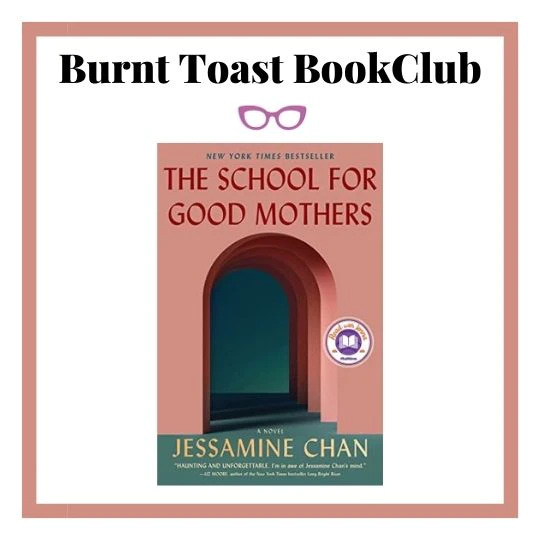








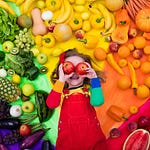

"Health Is About More Than Food. Health Is About The Whole Child."